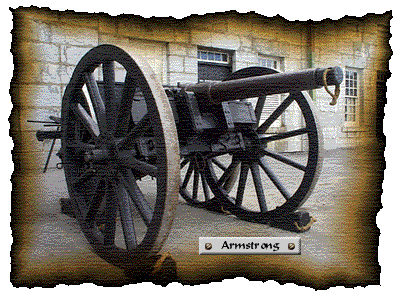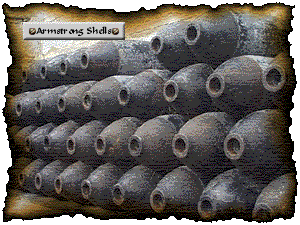
Rifling is a concept that has been known since the fifteenth century. This concept involves giving the projectile leaving the bore of the gun a twist. This twisting motion (rotational velocity) gives the projectile a steadiness in flight. This steadiness, in turn, leads to a longer range and more accuracy.

Although this concept had been known for a long time, the skill to implement it into the artillery of the day did not exist. Therefore, the concept remained dormant until...
The Crimean War spurred England into action. One of its outcomes was to revolutionize the field of artillery. The real breakthrough, which transformed the art of artillery into a science, occurred in 1855 when Armstrong brought out his wrought-iron breech-loading rifled gun, known as the RBL 40-pounder. It was adopted for service in 1859 as a result of a report rendered by a committee set up to recommend the best make of rifled gun for the Crown.
Armstrong guns were constructed of wrought-iron, built up by shrinking successive layers or coils of that material one over the other. It was this system of construction which, by employing the principle of initial stresses, enabled the outer layers of a built-up gun to bear a fair share of the firing stress. The Armstrong gun was definitely superior to the Smooth-Bore Muzzle-Loading gun. It was more accurate, more powerful and more durable.
However, experience proved that the Armstrong RBL gun was not satisfactory from an operational point of view. Difficulties arose regarding suitable ammunition and efficient obturation (seal in the breech of the gun). Large numbers of Armstrong guns were produced between 1859 and 1862. By 1863, £2,500,000 had been spent in equipping the army and navy. However, none were made after 1864. Those in store were eventually converted into muzzle-loaders.
As a result of the failure of the Armstrong RBL (rifled breech-loading) gun, a committee was appointed to consider the matter. The committee sat from 1863 to 1865. In 1870, it recommend the rifled muzzle-loading gun as a suitable alternative. Following the recommendations of these committees, RML (rifled muzzle-loading) ordnance was introduced and all RBL pieces were ordered to be converted. The first model was constructed on similar lines to the Armstrong gun, but as experience was gained, improvements in methods of manufacture were made.

![]()